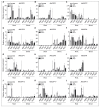The Importance of Conserved Serine for C-Terminally Encoded Peptides Function Exertion in Apple
- PMID: 30759748
- PMCID: PMC6387203
- DOI: 10.3390/ijms20030775
The Importance of Conserved Serine for C-Terminally Encoded Peptides Function Exertion in Apple
Abstract
Background: The C-terminally encoded peptide (CEP) family has been shown to play vital roles in plant growth. Although a genome-wide analysis of this family has been performed in Arabidopsis, little is known regarding CEPs in apple (Malus domestica).
Methods: Here, a comprehensive bioinformatics approach was applied to identify MdCEPs in apple, and 12 MdCEP genes were identified and distributed on 6 chromosomes.
Results: MdCEP1 peptide had an inhibitory effect on root growth of apple seedlings, indicating that MdCEP1 played a negative role in root development. In addition, the serine and glycine residues remained conserved within the CEP domains, and MdCEP1 lost its function after mutation of these two key amino acids, suggesting that Ser10 and Gly14 residues are crucial for MdCEPs-mediated root growth of apple. Encouragingly, multiple sequence alignment of 273 CEP domains showed that Ser10 residue was evolutionarily conserved in monocot and eudicot plants. MdCEP derivative (Ser to Cys) lost the ability to inhibit the root growth of Nicotiana benthamiana, Setaria italic, Samolous parviflorus, and Raphanus sativus L. and up-regulate the NO3- importer gene NRT2.1.
Conclusion: Taken together, Ser10 residue is crucial for CEP function exertion in higher land plants, at least in apple.
Keywords: C-terminally encoded peptide; Malus domestica; bioinformatics; phylogenetic analysis; root growth; secreted peptides.
Conflict of interest statement
The authors declare that they have no conflict of interest.
Figures








Similar articles
-
Genome-wide identification and expression analysis of brassinosteroid biosynthesis and metabolism genes regulating apple tree shoot and lateral root growth.J Plant Physiol. 2018 Dec;231:68-85. doi: 10.1016/j.jplph.2018.09.002. Epub 2018 Sep 10. J Plant Physiol. 2018. PMID: 30223145
-
Genome-wide identification of SERK genes in apple and analyses of their role in stress responses and growth.BMC Genomics. 2018 Dec 27;19(1):962. doi: 10.1186/s12864-018-5342-1. BMC Genomics. 2018. PMID: 30587123 Free PMC article.
-
CEP genes regulate root and shoot development in response to environmental cues and are specific to seed plants.J Exp Bot. 2013 Dec;64(17):5383-94. doi: 10.1093/jxb/ert332. Epub 2013 Oct 31. J Exp Bot. 2013. PMID: 24179096
-
Global identification and expression analysis of stress-responsive genes of the Argonaute family in apple.Mol Genet Genomics. 2016 Dec;291(6):2015-2030. doi: 10.1007/s00438-016-1236-6. Epub 2016 Jul 30. Mol Genet Genomics. 2016. PMID: 27475441
-
CEP peptide hormones: key players in orchestrating nitrogen-demand signalling, root nodulation, and lateral root development.J Exp Bot. 2018 Apr 9;69(8):1829-1836. doi: 10.1093/jxb/ery037. J Exp Bot. 2018. PMID: 29579226 Review.
Cited by
-
Phytocytokine genes newly discovered in Malus domestica and their regulation in response to Erwinia amylovora and acibenzolar-S-methyl.Plant Genome. 2025 Mar;18(1):e20540. doi: 10.1002/tpg2.20540. Epub 2024 Dec 8. Plant Genome. 2025. PMID: 39648642 Free PMC article.
-
Peptide hormones in plants.Mol Hortic. 2025 Jan 23;5(1):7. doi: 10.1186/s43897-024-00134-y. Mol Hortic. 2025. PMID: 39849641 Free PMC article. Review.
-
Initiation and maintenance of plant stem cells in root and shoot apical meristems.aBIOTECH. 2020 May 4;1(3):194-204. doi: 10.1007/s42994-020-00020-3. eCollection 2020 Jul. aBIOTECH. 2020. PMID: 36303567 Free PMC article. Review.
-
C-terminally encoded peptide-like genes are associated with the development of primary root at qRL16.1 in soybean.Front Plant Sci. 2024 Apr 15;15:1387954. doi: 10.3389/fpls.2024.1387954. eCollection 2024. Front Plant Sci. 2024. PMID: 38685962 Free PMC article.
-
Systematic Annotation Reveals CEP Function in Tomato Root Development and Abiotic Stress Response.Cells. 2022 Sep 20;11(19):2935. doi: 10.3390/cells11192935. Cells. 2022. PMID: 36230896 Free PMC article.
References
MeSH terms
Substances
Grants and funding
LinkOut - more resources
Full Text Sources

